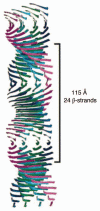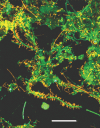Functional amyloid: turning swords into plowshares
- PMID: 20935497
- PMCID: PMC3268958
- DOI: 10.4161/pri.4.4.13676
Functional amyloid: turning swords into plowshares
Abstract
Evidence is growing at an increasing -pace that amyloid fibers are not just the result of aberrant protein folding associated with neurodegenerative diseases, but are widespread in nature for beneficial reasons. Amyloid is an attractive building material because its robust design and simple repetitive structure make for very durable and metabolically cheap material. But this requires that the production of amyloid be put under firm control. This appears to involve the use of four to five chaperones that are expressed under the control of the same promoter as the amyloid proteins. Significant progress has been made in deciphering this process in E. coli's csg operon, also found in Salmonella. Recently, we have discovered a new and unrelated operon (fap) responsible for amyloid production in Pseudomonas, which also confers biofilm-forming properties to E. coli. Intriguingly, this operon shares a number of features with csg, namely two homologous proteins (one of which, FapC, has been shown to be directly involved in amyloid build-up) and a small number of auxiliary proteins. However, FapC seems to be less economically structured than its E. coli counterpart, with a smaller number of repeats and very large and variable linker regions. Furthermore, the putative chaperones are not homologous to their csg counterparts and have intriguing homologies to proteins with other functions. These findings suggest that controlled amyloid production has arisen on many independent occasions due to the usefulness of the product and offers the potential for intriguing insights into how nature disarms and reconstructs a potentially very dangerous weapon.
Figures





References
Publication types
MeSH terms
Substances
LinkOut - more resources
Full Text Sources
Other Literature Sources
Miscellaneous
